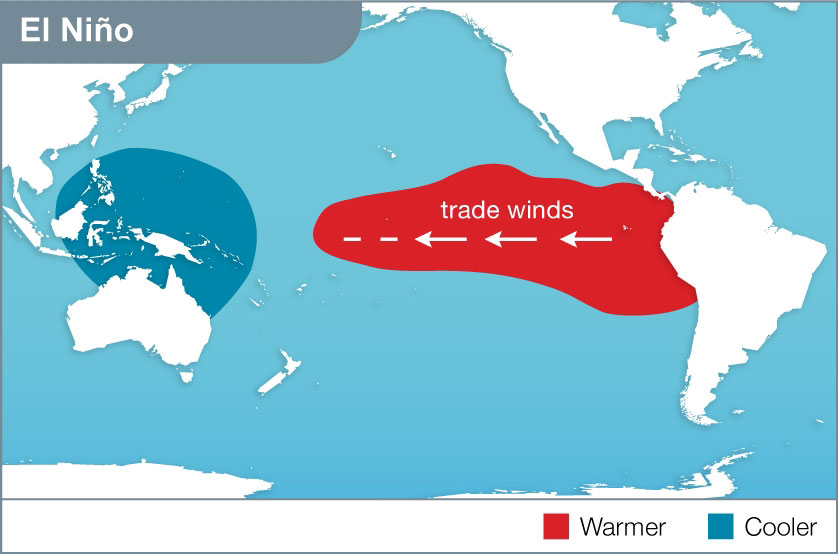As the world enters an El Niño phase—a natural climate phenomenon characterized by warmer waters in the Pacific—countries are bracing themselves for extreme weather events. The El Niño pattern fuels tropical cyclones in the Pacific, increases rainfall and flood risks in parts of the Americas and other regions, and can have far-reaching implications. This year’s El Niño is of particular concern due to its potential interaction with climate change, which could result in record-high temperatures and intensified extreme weather events.
-
The Arrival and Characteristics of El Niño: El Niño occurs when the trade winds in the equatorial Pacific slow down or reverse, causing unusually warm waters in the eastern Pacific. The weakening of trade winds leads to the movement of warm water from the western Pacific towards the central and eastern Pacific basins. This buildup of warm water contributes to the transfer of heat into the atmosphere, triggering thunderstorms and altering weather patterns worldwide.
- Global Weather Impact: El Niño significantly influences the movement of the subtropical jet stream—a high-altitude current of fast-flowing air that helps drive weather systems. During El Niño, the subtropical jet stream shifts southward and becomes flatter, affecting weather patterns along similar latitudes. Consequently, the United States experiences cooler and wetter conditions in the southern regions, while parts of the U.S. West and Canada tend to be warmer and drier.

Buy Prime Test Series for all Banking, SSC, Insurance & other exams
2.1 Impact on Atlantic Hurricanes and Pacific Cyclones: El Niño inhibits the formation of Atlantic hurricanes due to changes in wind patterns, providing some respite for the United States. However, the Pacific region experiences a boost in tropical cyclones, with storms often heading towards vulnerable islands. This poses a significant threat to those regions.
2.2 Effects on Central and South America: During El Niño, Central and South America can face heavy rainfall in some areas, while the Amazon rainforest may experience drier conditions. These changes in precipitation patterns can have implications for agriculture, water resources, and ecosystems in the region.
2.3 Australia’s Climate Extremes: Australia typically endures extreme heat, drought, and bushfires during El Niño events. The combination of warmer waters and altered atmospheric conditions exacerbates these conditions, increasing the risk of wildfires and straining water supplies.
2.4 Impact on the Horn of Africa: El Niño could bring relief to the Horn of Africa, which has experienced consecutive failed rainy seasons. Unlike the drier conditions associated with La Niña, El Niño can bring increased rainfall to the region, potentially alleviating water scarcity and supporting agricultural activities.
- El Niño and Climate Change: The relationship between El Niño and climate change is an area of ongoing research. While climate change can amplify the impacts of El Niño, it is uncertain whether it directly influences the occurrence and frequency of El Niño events. As global temperatures rise due to climate change, the interaction between El Niño and climate change could intensify extreme weather events, compounding the challenges faced by vulnerable regions.
Key Facts about El Niño
-
Definition: El Niño is a climate pattern characterized by unusually warm waters in the eastern Pacific Ocean near the equator.
- Cause: El Niño occurs when the trade winds along the equatorial Pacific weaken or reverse, leading to the movement of warm surface waters from the western Pacific towards the central and eastern Pacific.
- Effects on Weather: El Niño influences global weather patterns by altering the movement of the subtropical jet stream, which impacts the distribution of storms and rainfall.
- Weather Impacts: The effects of El Niño vary across different regions of the world. Southern parts of the United States generally experience cooler and wetter conditions, while regions in the U.S. West and Canada may become warmer and drier. Central and South America can experience heavy rainfall in some areas, while the Amazon rainforest may face drier conditions. Australia often encounters extreme heat, drought, and bushfires during El Niño events.
- Impact on Atlantic Hurricanes and Pacific Cyclones: El Niño typically suppresses the formation of Atlantic hurricanes but enhances tropical cyclones in the Pacific, increasing the risk for vulnerable islands.
- Horn of Africa: El Niño can bring relief to the Horn of Africa by increasing rainfall, potentially alleviating water scarcity and supporting agricultural activities.
- Duration: El Niño events typically last 9 to 12 months, but their occurrence is not regular and can vary in frequency from every two to seven years.
- Relationship with La Niña: El Niño is part of a natural climate cycle that alternates with La Niña, which is characterized by cooler waters in the eastern Pacific. Both El Niño and La Niña can have significant impacts on global weather patterns.
Find More International News Here




 Weekly Current Affairs One Liners 08th t...
Weekly Current Affairs One Liners 08th t...
 Which Indian City is Known as the Footwe...
Which Indian City is Known as the Footwe...
 Which Desert is known as the Cold Desert...
Which Desert is known as the Cold Desert...







